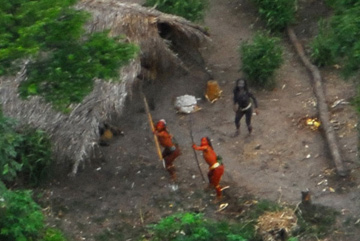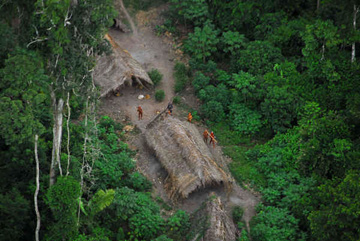Brazil to use body-heat sensing technology to find uncontacted Amazon tribes
mongabay.com
November 19, 2008
|
|
Brazil will use a plane equipped with body-heat sensing technology to locate tribes in the Amazon rainforest, reports the Associated Press.
The effort will enable FUNAI, Brazil’s Indian affairs agency, to push for the establishment of reserves to better protect isolated tribes from encroachment by loggers, miners, and ranchers. Developers aiming to clear land for timber, cattle pasture and farms have been known to hire bounty hunters to seek out and kill forest dwellers before authorities are aware of their presence.
  Photos of an uncontacted tribe in the Terra Indigena Kampa e Isolados do Envira, Acre state, Brazil, near the border with Peru, caused a stir when they were released by the Brazilian government in May 2008. The indigenous group, which authorities have known about for 20 years, is said to be threatened by oil exploration and illegal logging in the area. © Gleison Miranda/FUNAI. |
The plane will allow the Brazilian government to detect and monitor uncontacted tribes without the risk of infecting them with disease, which is the greatest threat to tribes upon first contact with the outside world. Until now authorities have relied on reports from contacted tribes and surveys on foot but monitoring is difficult in the expansive and remote region. Further because uncontacted rainforest tribes rarely erect permanent structures or live in groups much large than a couple dozen people, detecting them — much less protecting them — is a challenge.
Brazil has confirmed 26 native tribes that live with little to no contact with the outside world.
Some 22 percent of the Brazilian Amazon is demarcated as indigenous reserves.
BRADLEY BROOKS. Brazil: Body-heat sensors to track lost tribes. The Associated Press. 18 Nov 2008